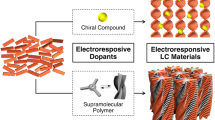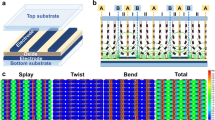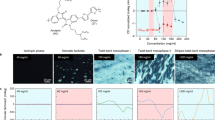Abstract
In the presence of a strong electric field, helices in a cholesteric liquid crystal (CLC) phase might be unwound, leaving liquid crystal (LC) molecules parallel to the electric field, thereby realizing transparency. Previously, we developed a novel particle-doped CLC cell without alignment layers that exhibited liquid crystal display (LCD) capabilities via electro-optical properties. This ability represents a novel advancement in LCD fabrication, resulting in enhanced electro-optical characteristics. To explore the impact of chirality on LCDs, we synthesized and radially constructed cellulose particles. These were then employed as chiral dopants in the production of LCD cells. The fabricated chiral nanoparticle (CNP)-doped PC05 CLC cell showed a high transparency of 97.4% and a fast response time of 7.6 ms. For the prepared radially constructed PDAT-doped PD2T PSCLC cell, a high transmittance of 93.6% and a fast response time of 13 ms were achieved. Fabrication of LCD cells without an alignment layer on substrates was achieved by indicate adding polymeric chiral nanoparticles into CLC mixtures. Adding 2 wt% chiral CNPs promoted the transmittance of the CLCs from 3.4 to 97%. This novel chiral dopant technique enables the use of a new easy method for the fabrication of LCDs.
This is a preview of subscription content, access via your institution
Access options
Subscribe to this journal
Receive 12 print issues and online access
$259.00 per year
only $21.58 per issue
Buy this article
- Purchase on Springer Link
- Instant access to full article PDF
Prices may be subject to local taxes which are calculated during checkout













Similar content being viewed by others
References
Yang B, Wang G, Xia B, Zhong M, Fan P, Chen F, et al. Enzymatic synthesis of chiral polyamide via condensation of natural source amino acid diesters and diamine. Macromol Chem Phys. 2021;222:2100162.
Zhang Y, Xia B, Li Y, Lin X, Wu Q. Substrate engineering in lipase-catalyzed selective polymerization of d-/l-aspartates and diols to prepare helical chiral polyester. Biomacromolecules. 2021;22:918–26.
Pschyklenk L, Wagner T, Lorenz A, Kaul P. Optical gas sensing with encapsulated chiral-nematic liquid crystals. ACS Appl Polym Mater. 2020;2:1925–32.
Yan J, Ota F, San Jose BA, Akagi K. Chiroptical resolution and thermal switching of chirality in conjugated polymer luminescence via selective reflection using a double-layered cell of chiral nematic liquid crystal. Adv Funct Mater. 2017;27:1604529.
Lu X, Zhou Z, Ni B, Li H, Li Y, Li B, et al. Tuning the circularly polarized luminescence of polymer-stabilized cholesteric liquid crystal films using chiral dopants. J Mater Chem C. 2022;10:8246–53.
Froyen AAF, Wübbenhorst M, Liu D, Schenning APHJ. Electrothermal color tuning of cholesteric liquid crystals using interdigitated electrode patterns. Adv Electron Mater. 2021;7:2000958.
Lu H, Hu J, Chu Y, Xu W, Qiu L, Wang X, et al. Cholesteric liquid crystals with an electrically controllable reflection bandwidth based on ionic polymer networks and chiral ions. J Mater Chem C. 2015;3:5406–11.
Lu H, Wang Q, Zhu M, Huang P, Xu M, Qiu L, et al. Electrically controllable reflection bandwidth polymer-stabilized cholesteric liquid crystals with low operating voltage. Liq Cryst. 2022;49:1314–21.
Inoue Y, Yoshida H, Inoue K, Shiozaki Y, Kubo H, Fujii A, et al. Tunable lasing from a cholesteric liquid crystal film embedded with a liquid crystal nanopore network. Adv Mater. 2011;23:5498–501.
White TJ, McConney ME, Bunning TJ. Dynamic color in stimuli-responsive cholesteric liquid crystals. J Mater Chem. 2010;20:9832–47.
Lu P, Chen Y, Chen Z, Yuan Y, Zhang H. Electric field, temperature and light-triggered triple dynamic circularly polarized luminescence switching in fluorescent cholesteric liquid crystals with a large dissymmetry factor. J Mater Chem C. 2021;9:6589–96.
Rouhbakhsh Z, Verdian A, Rajabzadeh G. Design of a liquid crystal-based aptasensing platform for ultrasensitive detection of tetracycline. Talanta. 2020;206:120246.
Tan H, Yang S, Shen G, Yu R, Wu Z. Signal-enhanced liquid-crystal DNA biosensors based on enzymatic metal deposition. Angew Chem Int Ed. 2010;49:8608–11.
Škarabot M, Osmanagič E, Muševič I. Surface anchoring of nematic liquid crystal 8OCB on a DMOAP‐silanated glass surface. Liq Cryst. 2006;33:581–5.
Zhang Y, Yang W, Gu M, Wei Q, Lv P, Li M, et al. Versatile homeotropic liquid crystal alignment with tunable functionality prepared by one-step method. J Colloid Interface Sci. 2022;608:2290–7.
Lee CS, Kumar TA, Kim JH, Lee JH, Gwag JS, Lee G-D, et al. An electrically switchable visible to infra-red dual frequency cholesteric liquid crystal light shutter. J Mater Chem C. 2018;6:4243–9.
Kumar P, Kang S-W, Lee SH. Advanced bistable cholesteric light shutter with dual frequency nematic liquid crystal. Opt Mater Express. 2012;2:1121–34.
Oh S-W, Baek J-M, Heo J, Yoon T-H. Dye-doped cholesteric liquid crystal light shutter with a polymer-dispersed liquid crystal film. Dyes Pigments. 2016;134:36–40.
Oh S-W, Kim S-H, Yoon T-H. Thermal control of transmission property by phase transition in cholesteric liquid crystals. J Mater Chem C. 2018;6:6520–5.
Liang X, Chen M, Wang Q, Guo S, Zhang L, Yang H. Active and passive modulation of solar light transmittance in a hybrid thermochromic soft-matter system for energy-saving smart window applications. J Mater Chem C. 2018;6:7054–62.
Liu C-Y, Yen C-F, Hung Y-H, Tu C-M, Wu G-Y, Chen H-Y. Polymer-stabilized bistable dual-frequency cholesteric liquid crystal devices assisted by a predesigned chiral dopant. J Mater Chem C. 2021;9:16672–81.
Maiti UN, Lee WJ, Lee JM, Oh Y, Kim JY, Kim JE, et al. 25th Anniversary Article: Chemically modified/doped carbon nanotubes & graphene for optimized nanostructures & nanodevices. Adv Mater. 2014;26:40–67.
Jian B-R, Tang C-Y, Lee W. Temperature-dependent electrical properties of dilute suspensions of carbon nanotubes in nematic liquid crystals. Carbon. 2011;49:910–4.
Ma Z, Han Y, Li Z, Zhang Y, Zhang H, Zheng G, et al. Effects of nematic liquid crystal doped with multi-walled carbon nanotube on electro-optic properties and electrostatic discharge immunity of liquid crystal display device. Liq Cryst. 2023;50:505–18.
Cook G, Reshetnyak VY, Ziolo RF, Basun SA, Banerjee PP, Evans DR. Asymmetric Freedericksz transitions from symmetric liquid crystal cells doped with harvested ferroelectric nanoparticles. Opt Express. 2010;18:17339–45.
Gdovinová V, Tomašovičová N, Jeng S-C, Zakutanská K, Kula P, Kopčanský P. Memory effect in nematic phase of liquid crystal doped with magnetic and non-magnetic nanoparticles. J Mol Liq. 2019;282:286–91.
Gorkunov MV, Osipov MA. Mean-field theory of a nematic liquid crystal doped with anisotropic nanoparticles. Soft Matter. 2011;7:4348–56.
Haraguchi F, Inoue K-I, Toshima N, Kobayashi S, Takatoh K. Reduction of the threshold voltages of nematic liquid crystal electrooptical devices by doping inorganic nanoparticles. Jpn J Appl Phys. 2007;46:L796.
Kumar A, Prakash J, Khan MT, Dhawan SK, Biradar AM. Memory effect in cadmium telluride quantum dots doped ferroelectric liquid crystals. Appl Phys Lett. 2010;97:163113.
Kinkead B, Hegmann T. Effects of size, capping agent, and concentration of CdSe and CdTe quantum dots doped into a nematic liquid crystal on the optical and electro-optic properties of the final colloidal liquid crystal mixture. J Mater Chem. 2010;20:448–58.
Lapanik V, Timofeev S, Haase W. Electro-optic properties of nematic and ferroelectric liquid crystalline nanocolloids doped with partially reduced graphene oxide. Phase Transit. 2016;89:133–43.
Zhang W, Wang X, Wang D, Yang Z, Gao H, Xing Y, et al. Blue phase liquid crystals affected by graphene oxide modified with aminoazobenzol group. Liq Cryst. 2016;43:573–80.
Ni S, Li H, Li S, Zhu J, Tan J, Sun X, et al. Low-voltage blue-phase liquid crystals with polyaniline-functionalized graphene nanosheets. J Mater Chem C. 2014;2:1730–5.
Kocakülah G, Algül G, Köysal O. Effect of CdSeS/ZnS quantum dot concentration on the electro-optical and dielectric properties of polymer stabilized liquid crystal. J Mol Liq. 2020;299:112182.
Kocakülah G, Balci S, Köysal O. Determination of phase transition and electro-optical behaviors of quantum dot doped polymer dispersed liquid crystal. J Electron Mater. 2020;49:3427–34.
Liu X, Wei R, Hoang PT, Wang X, Liu T, Keller P. Reversible and rapid laser actuation of liquid crystalline elastomer micropillars with inclusion of gold nanoparticles. Adv Funct Mater. 2015;25:3022–32.
Draper M, Saez IM, Cowling SJ, Gai P, Heinrich B, Donnio B, et al. Self-assembly and shape morphology of liquid crystalline gold metamaterials. Adv Funct Mater. 2011;21:1260–78.
Middha M, Kumar R, Raina KK. Effects of chirality on optical and electro-optic behavior of nematic liquid crystals doped with functionalized silver nanoparticles. J Mol Liq. 2016;219:631–6.
Singh UB, Dhar R, Dabrowski R, Pandey MB. Influence of low concentration silver nanoparticles on the electrical and electro-optical parameters of nematic liquid crystals. Liq Cryst. 2013;40:774–82.
Mishra M, Dabrowski RS, Vij JK, Mishra A, Dhar R. Electrical and electro-optical parameters of 4ʹ-octyl-4-cyanobiphenyl nematic liquid crystal dispersed with gold and silver nanoparticles. Liq Cryst. 2015;42:1580–90.
Bednarska K, Oszwa P, Bartosewicz B, Jankiewicz B, Lesiak P, Ertman S, et al. Enhancement of thermal and electro-optical properties of photonic crystal fibers infiltrated with a modified 6CHBT nematic liquid crystal doped with gold nanoparticles. Opt Mater. 2019;98:109419.
Wojcik M, Lewandowski W, Matraszek J, Mieczkowski J, Borysiuk J, Pociecha D, et al. Liquid-crystalline phases made of gold nanoparticles. Angew Chem Int Ed. 2009;48:5167–9.
Nishida N, Shiraishi Y, Kobayashi S, Toshima N. Fabrication of liquid crystal sol containing capped Ag−Pd bimetallic nanoparticles and their electro-optic properties. J Phys Chem C. 2008;112:20284–90.
Kobayashi S, Miyama T, Nishida N, Sakai Y, Shiraki H, Shiraishi Y, et al. Dielectric spectroscopy of metal nanoparticle doped liquid crystal displays exhibiting frequency modulation response. J Disp Technol. 2006;2:121–9.
Wu G-Y, Chang K-T, Ou S-Y, Zhuang C-H, Liu C-Y. Polymer beads dispersed liquid crystal devices (PBLCD) achieved by predesigned radially constructed polymeric particles. J Appl Polym Sci. 2022;139:e53037.
Acknowledgements
The authors would like to thank the National Science and Technology Council (NSTC) of the Republic of China (Taiwan) for financially supporting this research under Contract MOST 111-2221-E-006-156. This research was also supported in part by the Higher Education Sprout Project, Ministry of Education to the Headquarters of University Advancement at National Cheng Kung University (NCKU).
Author information
Authors and Affiliations
Corresponding author
Ethics declarations
Conflict of interest
The authors declare no competing interests.
Additional information
Publisher’s note Springer Nature remains neutral with regard to jurisdictional claims in published maps and institutional affiliations.
Supplementary information
Rights and permissions
Springer Nature or its licensor (e.g. a society or other partner) holds exclusive rights to this article under a publishing agreement with the author(s) or other rightsholder(s); author self-archiving of the accepted manuscript version of this article is solely governed by the terms of such publishing agreement and applicable law.
About this article
Cite this article
Kuo, CY., Emelyanenko, A.V., Hung, SC. et al. Improving the electro-optical properties of cholesteric liquid crystal devices via cellulose nanoparticle dopants. Polym J 56, 541–551 (2024). https://doi.org/10.1038/s41428-023-00879-1
Received:
Revised:
Accepted:
Published:
Issue Date:
DOI: https://doi.org/10.1038/s41428-023-00879-1



